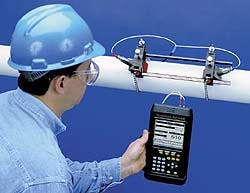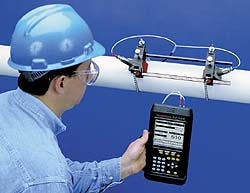New Portable Ultrasonic Flowmeter Offers Flexibility
Typical water and wastewater facilities have a wide variety of pipes transporting a range of fluids. A new transit-time portable flowmeter can be used to track flows in all types of pipes and conditions, without cutting or tapping the pipe, and with no pressure drop.
Panametrics' new TransPort® PT878 flowmeter features compact ultrasonic transducers which are clamped onto the pipe, one upstream of the other. Both transducers send coded ultrasonic signals to one another through the pipe wall and fluid. The transit-time in the direction of flow is faster compared to the transit-time against the flow. The difference in transit-times is used to calculate velocity and flow.
There are several benefits to this technology. First, flow can be measured bi-directionally since the difference in transit-time just changes sign (-) for reverse flow. Also, with clamp-on transducers, there is no need to drill or tap the pipe. Lastly, the installation is non-wetted and obstructionless, resulting in a setup that causes zero pressure drop.
The PT878's microprocessor-based electronics use digital signal processing (DSP) and patented Correlation Transit-Time™ algorithms to aid in signal detection, even in set-ups with low signal-to-noise ratio. The system can handle clean liquids or liquids with up to 15-20 percent entrained solids by volume with little problem.
Clamp-on set-up can be done in as little as 15-20 minutes. The first step is to pick an installation point with a bit of straight-run and affix the clamping fixture onto the pipe. The next step is to input parameters such as pipe size, wall thickness (determined using the PT878's on-board thickness gauge option), expected fluid, and temperature to determine spacing for the transducers. Operators then install the transducers into the fixture with a dab of acoustic grease and attach the transducer cables. The meter immediately starts taking measurements.
The PT878 incorporates new, advanced Reynolds number correction algorithms that take into account the surface roughness of the inside surface of the pipe and gives more accurate results in turbulent flow. The default roughness factor covers almost all commercial pipes and allows for an improved accuracy specification of ±1 percent of reading.
PortabilityOne of the most common applications is verification of an inline flowmeter. Whether the inline meter is a magmeter, oriface plate, vortex shedding or other technology, all the operator has to do is clamp on the portable ultrasonic flowmeter right next to it (preferably upstream to avoid a distorted flow profile). Within minutes, the inline meter can be verified. This has proven very important for customers who use their dedicated inline flowmeters for custody transfer applications and want a quick means of checking their performance.The clamp-on flowmeters also can be used where there is no installed meter. Flow surveys can be done for periods of up to 6-8 hours using the PT878's built-in battery. Many users log flow data during tests and then export the data via an infrared port to a computer running Panametric's PanaView Instrument Interface Software. A common scenario here is to use the portable meter to check various legs of a system and then use the data to do a flow balance of the process.
How do operators know a clamp-on transit-time installation is providing accurate flow information? The PT878 can provide diagnostic measurements of the fluid soundspeed. If the soundspeed measurement of the fluid is close to published data, then operators know the installation is good and that the flow data can be relied on. WW/


